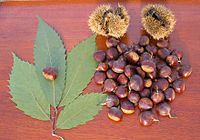
Chinese chestnut yellow crinkle disease influence microbiota composition of chestnut trees.
Sign Up to like & getrecommendations! Published in 2020 at "Microbial pathogenesis"
DOI: 10.1016/j.micpath.2020.104606
Abstract: CONTEXT Candidatus-phytoplasma castaneae has been found as the causal agent of the Chinese chestnut yellow crinkle disease. However, the ecological impact of the disease on microbiota of chestnut trees is unknown. AIMS The study aim… read more here.
Keywords: yellow crinkle; chestnut; disease; chestnut trees ... See more keywords

Amino acid composition and nutritional value evaluation of Chinese chestnut (Castanea mollissima Blume) and its protein subunit
Sign Up to like & getrecommendations! Published in 2018 at "RSC Advances"
DOI: 10.1039/c7ra13007d
Abstract: The amino acid composition, nutritional value and proteins subunit of chestnuts (Castanea mollissima Blume) from three regions of China (Henan, Hunan, and Guangdong) were investigated. Experimental results showed that the albumin fraction dominated the chestnut… read more here.
Keywords: amino; amino acid; composition; kda kda ... See more keywords

First report of Colletotrichum henanense causing anthracnose on Chinese chestnut in the United States.
Sign Up to like & getrecommendations! Published in 2022 at "Plant disease"
DOI: 10.1094/pdis-12-21-2661-pdn
Abstract: Culinary chestnut production in the United States (US) is a rapidly growing industry supporting fresh market and value-added industries. An estimated 200-400 new acres of chestnuts are planted every year in the US, with most… read more here.
Keywords: chestnut; chinese chestnut; first report; henanense causing ... See more keywords

Diversity of Monochaetia Species from Fagaceous Leaf Spots in China and Pathogenicity for Chinese Chestnut
Sign Up to like & getrecommendations! Published in 2023 at "Microbiology Spectrum"
DOI: 10.1128/spectrum.00042-23
Abstract: Monochaetia is a pestalotioid genus, with members that are commonly known as leaf pathogens or saprobes; some strains were isolated from air, in which case their natural substrate is so far unknown. Fagaceae represents an… read more here.
Keywords: chinese chestnut; pathogenicity; monochaetia species; present study ... See more keywords

Genetic evidence that Chinese chestnut cultivars in Japan are derived from two divergent genetic structures that originated in China
Sign Up to like & getrecommendations! Published in 2020 at "PLoS ONE"
DOI: 10.1371/journal.pone.0235354
Abstract: The Chinese chestnut (Castanea mollissima Bl.) was introduced into Japan about 100 years ago. Since then, a number of Chinese chestnut cultivars and Japanese–Chinese hybrid cultivars have been selected by farmers and plant breeders, but… read more here.
Keywords: chestnut; japanese chinese; chestnut cultivars; hybrid cultivars ... See more keywords

Genome-wide identification, evolution and transcriptome analysis of GRAS gene family in Chinese chestnut (Castanea mollissima)
Sign Up to like & getrecommendations! Published in 2023 at "Frontiers in Genetics"
DOI: 10.3389/fgene.2022.1080759
Abstract: GRAS transcription factors play an important role in regulating various biological processes in plant growth and development. However, their characterization and potential function are still vague in Chinese chestnut (Castanea mollissima), an important nut with… read more here.
Keywords: chinese chestnut; analysis; gene; castanea mollissima ... See more keywords

Beta-Amylase and Phosphatidic Acid Involved in Recalcitrant Seed Germination of Chinese Chestnut
Sign Up to like & getrecommendations! Published in 2022 at "Frontiers in Plant Science"
DOI: 10.3389/fpls.2022.828270
Abstract: Chinese chestnut (Castanea mollissima), a species with recalcitrant seeds, is an important source of nuts and forest ecosystem services. The germination rate of recalcitrant seeds is low in natural habitats and decreases under conditions of… read more here.
Keywords: seed germination; chinese chestnut; beta amylase; seed ... See more keywords

Genetic Diversity and Population Structure of Chinese Chestnut (Castanea mollissima Blume) Cultivars Revealed by GBS Resequencing
Sign Up to like & getrecommendations! Published in 2022 at "Plants"
DOI: 10.3390/plants11243524
Abstract: Chinese chestnut (Castanea mollissima Bl.) is one of the earliest domesticated and cultivated fruit trees, and it is widely distributed in China. Because of the high quality of its nuts and its high resistance to… read more here.
Keywords: chestnut; chinese chestnut; genetic diversity; analysis ... See more keywords